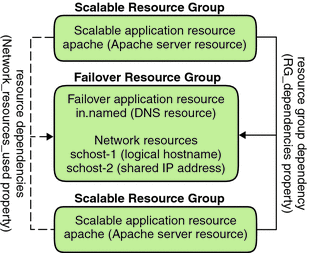Scalable Data Services
The scalable data service has the potential for active instances on multiple nodes.
Scalable services use the following two resource groups:
-
A scalable resource group contains the application resources.
-
A failover resource group, which contains the network resources (shared addresses) on which the scalable service depends. A shared address is a network address. This network address can be bound by all scalable services that are running on nodes within the cluster. This shared address enables these scalable services to scale on those nodes. A cluster can have multiple shared addresses, and a service can be bound to multiple shared addresses.
A scalable resource group can be online on multiple nodes simultaneously. As a result, multiple instances of the service can be running at once. All scalable resource groups use load balancing. All nodes that host a scalable service use the same shared address to host the service. The failover resource group that hosts the shared address is online on only one node at a time.
Service requests enter the cluster through a single network interface (the global interface). These requests are distributed to the nodes, based on one of several predefined algorithms that are set by the load-balancing policy. The cluster can use the load-balancing policy to balance the service load between several nodes. Multiple global interfaces can exist on different nodes that host other shared addresses.
For scalable services, application instances run on several nodes simultaneously. If the node that hosts the global interface fails, the global interface fails over to another node. If an application instance that is running fails, the instance attempts to restart on the same node.
If an application instance cannot be restarted on the same node, and another unused node is configured to run the service, the service fails over to the unused node. Otherwise, the service continues to run on the remaining nodes, possibly causing a degradation of service throughput.
Note –
TCP state for each application instance is kept on the node with the instance, not on the global interface node. Therefore, failure of the global interface node does not affect the connection.
Figure 3–7 shows an example of failover and a scalable resource group and the dependencies that exist between them for scalable services. This example shows three resource groups. The failover resource group contains application resources for highly available DNS, and network resources used by both highly available DNS and highly available Apache Web Server (used in SPARC-based clusters only). The scalable resource groups contain only application instances of the Apache Web Server. Note that resource group dependencies exist between the scalable and failover resource groups (solid lines). Additionally, all the Apache application resources depend on the network resource schost-2, which is a shared address (dashed lines).
Figure 3–7 SPARC: Failover and Scalable Resource Group Example

- © 2010, Oracle Corporation and/or its affiliates
